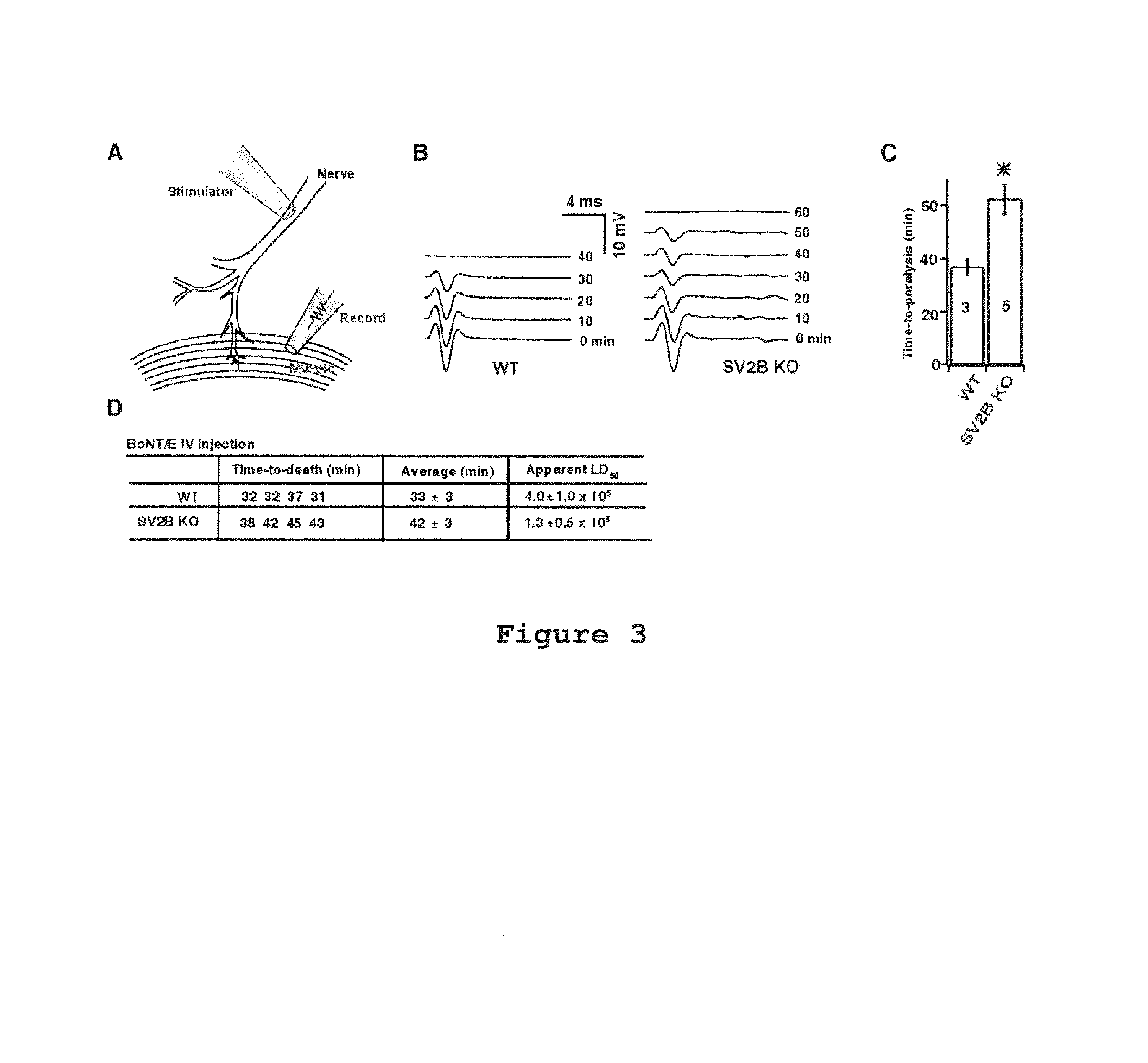Botulinum neurotoxin E receptors and uses thereof
a technology of neurotoxin and receptor, which is applied in the direction of immunoglobulins, peptides, drugs against animals/humans, etc., can solve the problems of flaccid paralysis, and the inability to use bonts to treat non-neuronal cells for excessive secretion, etc., to restore the binding and entry of bonts/e, and reduce the sensitivity to bonts/e
- Summary
- Abstract
- Description
- Claims
- Application Information
AI Technical Summary
Benefits of technology
Problems solved by technology
Method used
Image
Examples
example 1
BoNT / E Enters Neurons Via Recycling Synaptic Vesicles and Co-Immunoprecipitates with SV2
[0113]In the first series of experiments, we determined whether BoNT / E enters neurons via synaptic vesicle recycling—the dominant form of membrane recycling that occurs in presynaptic nerve terminals. Synaptic vesicle exocytosis exposes the luminal domains of synaptic vesicle proteins onto the cell surface, where they can serve as toxin binding sites. Exocytosis of synaptic vesicles can be triggered by depolarizing neurons with buffers containing a high concentration of K+, and can be blocked by treating neurons with tetanus neurotoxin (TeNT), which cleaves Syb4. Using cultured hippocampal neurons as a model, we found that stimulation of neurons with high K+ resulted in increased binding of BoNT / E (FIG. 1a). Depolarization of neurons with high K+ also increased the binding of an antibody that recognizes the luminal domain of Syt I (Syt IN Ab), which serves as an internal control to monitor the ex...
example 2
SV2A or SV2B is Required for the Binding and Entry of BoNT / E into Neurons
[0115]Next, we determined whether BoNT / E·SV2 interactions play functional roles in the binding and entry of BoNT / E into neurons. Among the three SV2 isoforms, knockout (KO) mice have been generated for SV2A and B, but not C47, 48. Since hippocampal neurons express mainly SV2A and B, neurons from SV2A / B double KO mice serve as a useful loss-of-function model in which we could examine whether the binding and entry of BoNT / E depends on the expression of SV235, 40, 49.
[0116]SV2A / B double knockout mice were generated by breeding SV2A(+ / −)SV2B(− / −) mice with each other. Thus, all of the new-born mice were SV2B(− / −), with varying levels of SV2A: SV2A(+ / +), SV2A(+ / −), SV2A(− / −). Neurons cultured from these littermates were exposed to BoNT / B and E simultaneously, and toxin-binding was assayed via immunocytochemistry. We found that binding of BoNT / E to SV2A(+ / −) neurons was reduced (FIG. 2a, middle panel) compared to SV2...
example 3
SV2B KO Mice Display Reduced Sensitivity to BoNT / E
[0121]BoNTs cause death in humans and animals by blocking the release of neurotransmitters from motor nerve terminals at the diaphragm51. These motor nerve terminals express all three isoforms of SV235, 50. Since SV2C KO mice have not been generated and SV2A KO mice do not survive to adulthood47, 48, we determined whether motor nerve terminals from SV2B KO mice display decreased susceptibility to BoNT / E compared to motor nerve terminals from WT mice. To test this, we used a phrenic nerve and diaphragm preparation (FIG. 3a)52. Stimulation of the phrenic nerve triggers the contraction of the diaphragm muscle, which can be recorded as an extracellular field potential (EFP) (FIG. 3a, b). The EFPs in both WT and SV2B KO last more than 3 hrs in the absence of BoNT / E (data not shown), consistent with a previous report52. The EFPs are similar between SV2B KO and WT before adding BoNT / E (FIG. 3b, 0 min). After a brief exposure to BoNT / E (10 n...
PUM
| Property | Measurement | Unit |
|---|---|---|
| solubility | aaaaa | aaaaa |
| solubility | aaaaa | aaaaa |
| solubility | aaaaa | aaaaa |
Abstract
Description
Claims
Application Information
 Login to View More
Login to View More - R&D
- Intellectual Property
- Life Sciences
- Materials
- Tech Scout
- Unparalleled Data Quality
- Higher Quality Content
- 60% Fewer Hallucinations
Browse by: Latest US Patents, China's latest patents, Technical Efficacy Thesaurus, Application Domain, Technology Topic, Popular Technical Reports.
© 2025 PatSnap. All rights reserved.Legal|Privacy policy|Modern Slavery Act Transparency Statement|Sitemap|About US| Contact US: help@patsnap.com



